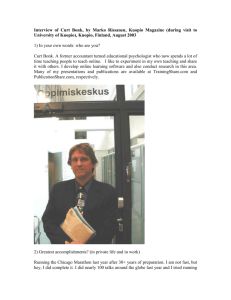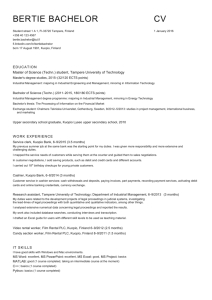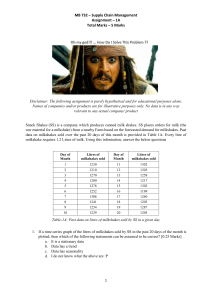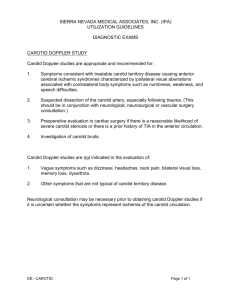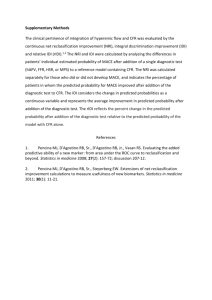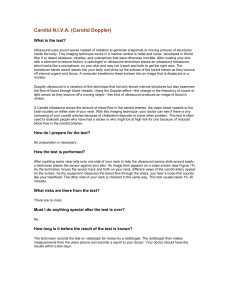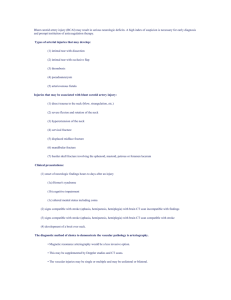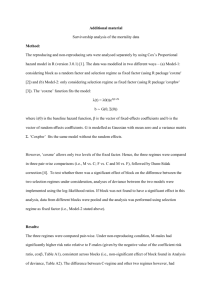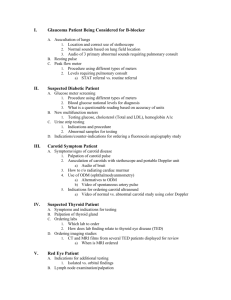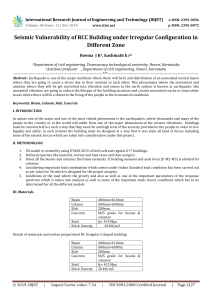appendix
advertisement
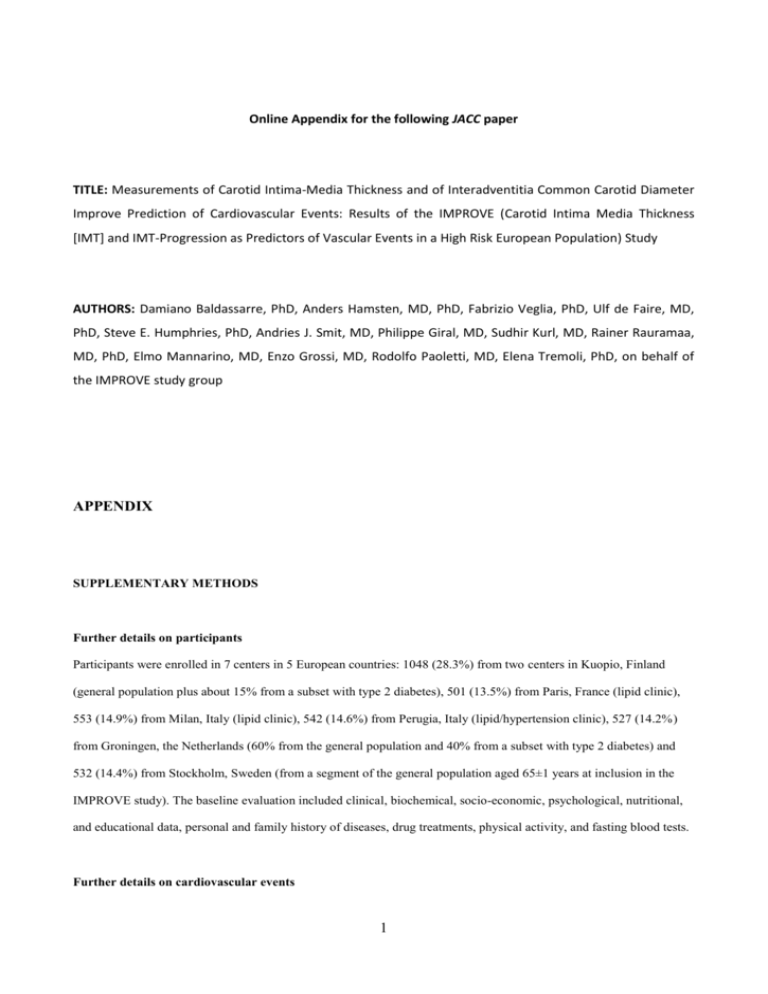
Online Appendix for the following JACC paper TITLE: Measurements of Carotid Intima-Media Thickness and of Interadventitia Common Carotid Diameter Improve Prediction of Cardiovascular Events: Results of the IMPROVE (Carotid Intima Media Thickness [IMT] and IMT-Progression as Predictors of Vascular Events in a High Risk European Population) Study AUTHORS: Damiano Baldassarre, PhD, Anders Hamsten, MD, PhD, Fabrizio Veglia, PhD, Ulf de Faire, MD, PhD, Steve E. Humphries, PhD, Andries J. Smit, MD, Philippe Giral, MD, Sudhir Kurl, MD, Rainer Rauramaa, MD, PhD, Elmo Mannarino, MD, Enzo Grossi, MD, Rodolfo Paoletti, MD, Elena Tremoli, PhD, on behalf of the IMPROVE study group APPENDIX SUPPLEMENTARY METHODS Further details on participants Participants were enrolled in 7 centers in 5 European countries: 1048 (28.3%) from two centers in Kuopio, Finland (general population plus about 15% from a subset with type 2 diabetes), 501 (13.5%) from Paris, France (lipid clinic), 553 (14.9%) from Milan, Italy (lipid clinic), 542 (14.6%) from Perugia, Italy (lipid/hypertension clinic), 527 (14.2%) from Groningen, the Netherlands (60% from the general population and 40% from a subset with type 2 diabetes) and 532 (14.4%) from Stockholm, Sweden (from a segment of the general population aged 65±1 years at inclusion in the IMPROVE study). The baseline evaluation included clinical, biochemical, socio-economic, psychological, nutritional, and educational data, personal and family history of diseases, drug treatments, physical activity, and fasting blood tests. Further details on cardiovascular events 1 Among the 215 subjects who developed a VE, 34 had an MI (7 fatal), 49 experienced symptoms of angina pectoris, 26 underwent angioplasty and 13 coronary bypass grafting, 3 suffered sudden cardiac death, 32 had an ischemic stroke (0 fatal), 41 had a transient ischemic attack, 4 subjects underwent revascularization due to peripheral artery disease and 13 had a new diagnosis of intermittent claudication. 80 participants had more than one VE during follow up, but only the first event was used for the analysis of the primary combined end point. Further details on subjects lost to follow-up A total of 238 subjects (6.4%) dropped out after the baseline visit (91 by withdrawing informed consent, 49 because of failure to attend follow up, 10 due to cancer, 1 due to hemiparesis after hemorrhagic stroke (only ischemic strokes were considered as CVEs), 2 because of dementia and 3 for health reasons not related to vascular disease, 12 moved to another city and 70 were lost for unknown reasons. Further details on statistical analysis The recorded CVEs provided a statistical power of 90% to detect as significant (alpha=0.05) a hazard ratio (HR) of 1.23 for one standard deviation increase in C-IMT in a univariable model, or a HR of 1.26 in a multivariable model (assuming R2=0.25 among covariates). The Integrated Discrimination Improvement (IDI),(1) the Net Reclassification Improvement (NRI)(2) and the area under the ROC curve using the logistic approach (C-statistics) were used to identify the best predictive segment in the common carotid, bifurcation or internal carotid arteries and the best summary measure among IMT mean, IMTmax or IMTmean-max, alone or in combination with ICCAD. Risk prediction models including the C-IMT measures to be tested were compared with models including CC-IMTmean alone, the single most utilized C-IMT measure. Subsequently, in order to evaluate the potential of ultrasonographic variables to improve risk prediction based on VRFs, models including Framingham risk factors (FRFs: age, gender, total cholesterol, HDL-cholesterol, systolic blood pressure, hypertension, diabetes, current smoking and antihypertensive treatments) were compared with models including C-IMT and ICCAD, alone or in combination with FRFs. The conclusions of the study were based on the IDI index, because it has been shown to be the most powerful reclassification method (1-4) and because it is not based on arbitrary risk categories, as NRI is. However, as recommended by Pencina et al.,(2) IDI confidence intervals were computed at 99%, and differences were deemed as significant when p-values were below 0.01. NRI and C-statistics results are also reported, to allow comparison of our results with the previous reports. For the calculation of the C-statistics, NRI and IDI, no censored data are allowed. Therefore, the follow-up was truncated at 36 months; all subjects censored up to this time were ignored. This means that in this type of analyses 176 instead of 215 VEs were considered. 2 CC-IMTmax 1stCC-IMTmax Bif-IMTmax ICA-IMTmax IMTmean IMTmax IMTmean-max ICCAD ICA-IMTmean ICA-IMTmean Bif-IMTmean Bif-IMTmean 1stCC-IMTmean 1stCC-IMTmean CC-IMTmean CC-IMTmean Online Table 1. Spearman correlation among ultrasonographic variables 1.00 0.79 0.37 0.32 0.87 0.70 0.30 0.30 0.64 0.38 0.57 0.54 1.00 0.42 0.31 0.70 0.91 0.34 0.29 0.67 0.40 0.59 0.51 1.00 0.41 0.35 0.39 0.91 0.41 0.85 0.81 0.79 0.32 1.00 0.28 0.30 0.39 0.93 0.71 0.56 0.69 0.32 1.00 0.69 0.30 0.28 0.58 0.38 0.59 0.47 1.00 0.33 0.29 0.62 0.40 0.60 0.47 1.00 0.40 0.76 0.87 0.81 0.27 1.00 0.68 0.60 0.73 0.30 1.00 0.84 0.93 0.49 1.00 0.92 0.34 1.00 0.45 CC-IMTmax 1stCC-IMTmax Bif-IMTmax ICA-IMTmax IMTmean IMTmax IMTmean-max 1.00 ICCAD All p<0.0001 3 Online Table 2. Hazard Ratios (95% C.I.) of combined hard coronary (34 myocardial infarction plus 3 sudden cardiac death) and cerebrovascular (32 ischemic stroke) endpoints per 1 standard deviation increase for ultrasonographic continuous (Log-transformed) variables. Model-1 Coronary (MI, sudden cardiac death) (n=37) Model-2 Model-1 Cerebrovascular (ischemic stroke) (n=32) Model-2 Model-3 Model-3 CC-IMTmean 1.24 (0.93-1.67) 1.06 (0.78-1.46) 1.06 (0.75-1.48) 1.6 (1.22-2.08)* 1.46 (1.09-1.94) 1.29 (0.93-1.8) 1stCC-IMTmean 1.17 (0.87-1.57) 1 (0.73-1.38) 0.95 (0.68-1.34) 1.7 (1.3-2.21)* 1.58 (1.19-2.1)* 1.49 (1.1-2.02) Bif-IMTmean 1.11 (0.81-1.54) 0.95 (0.67-1.33) 0.95 (0.66-1.36) 1.54 (1.11-2.14) 1.38 (0.98-1.95) 1.36 (0.95-1.96) ICA-IMTmean 1.07 (0.77-1.49) 0.92 (0.64-1.3) 0.88 (0.61-1.27) 1.73 (1.29-2.32)* 1.6 (1.17-2.17)* 1.45 (1.05-2.02) CC-IMTmax 1.18 (0.88-1.58) 1.03 (0.75-1.41) 1.04 (0.74-1.45) 1.49 (1.14-1.95)* 1.37 (1.03-1.83) 1.25 (0.91-1.73) 1stCC-IMTmax 1.18 (0.88-1.57) 1.04 (0.76-1.42) 1 (0.71-1.41) 1.64 (1.27-2.1)* 1.55 (1.19-2.02)* 1.44 (1.08-1.93) Bif-IMTmax 1.07 (0.77-1.49) 0.93 (0.66-1.31) 0.96 (0.66-1.38) 1.5 (1.07-2.11) 1.36 (0.96-1.93) 1.35 (0.93-1.97) ICA-IMTmax 1.2 (0.87-1.66) 1.06 (0.76-1.47) 1.03 (0.73-1.46) 1.75 (1.27-2.4)* 1.6 (1.15-2.22) 1.48 (1.04-2.12) IMTmean 1.12 (0.82-1.54) 0.9 (0.64-1.28) 0.87 (0.6-1.27) 1.93 (1.43-2.62)* 1.77 (1.28-2.46)* 1.62 (1.14-2.31) IMTmax 1.15 (0.83-1.59) 0.98 (0.69-1.38) 1.01 (0.7-1.46) 1.78 (1.25-2.52)* 1.6 (1.11-2.31)§ 1.51 (1.02-2.23) IMTmean-max 1.16 (0.85-1.6) 0.96 (0.68-1.35) 0.96 (0.66-1.39) 1.96 (1.42-2.7)* 1.79 (1.27-2.51)* 1.66 (1.14-2.42) ICCAD 1.47 (1.09-1.98) 1.2 (0.86-1.69) 1.25 (0.87-1.81) 2.05 (1.52-2.75)* 1.96 (1.39-2.75)* 1.97 (1.32-2.95)* Model-1: unadjusted, Model-2: adjusted for age and gender, Model-3: adjusted for age, gender, LDL-C, HDL-C, systolic blood pressure, personal history of diabetes and of hypertension, family history of diabetes, family history of hypertension, pack-years, pharmacological treatments (statins, beta-blockers, ACE inhibitors, diuretics and calcium antagonists) and stratified by center. Hazard ratios with p<0.05 are in bold, *P<0.004167: threshold according to Bonferroni correction for 12 comparisons. This threshold was selected even if some of IMT variables were not statistically independent (for example IMT mean-max and IMTmean) in order to be conservative. 4 5 SUPPLEMENTARY REFERENCES 1. Cook NR, Ridker PM. Advances in measuring the effect of individual predictors of cardiovascular risk: the role of reclassification measures. Ann Intern Med 2009;150:795-802. 2. Pencina MJ, D'Agostino RB, Sr., D'Agostino RB, Jr., Vasan RS. Evaluating the added predictive ability of a new marker: from area under the ROC curve to reclassification and beyond. Stat Med 2008;27:157-72; discussion 207-12. 3. Lorenz MW, Schaefer C, Steinmetz H, Sitzer M. Is carotid intima media thickness useful for individual prediction of cardiovascular risk? Ten-year results from the Carotid Atherosclerosis Progression Study (CAPS). Eur Heart J 2010;31:2041-8. 4. Fadini GP, Maruyama S, Ozaki T, et al. Circulating progenitor cell count for cardiovascular risk stratification: a pooled analysis. PLoS One 2010;5:e11488. 6 ACKNOWLEDGMENTS The authors wish to express their deep and sincere appreciation to all members of the IMPROVE group for their time and extraordinary commitment. The IMPROVE study group Dipartimento di Scienze Farmacologiche e Biomolecolari, Università di Milano, Milan, Italy: C. R. Sirtori, S. Castelnuovo. Centro Cardiologico Monzino, IRCCS, Milan Italy: M. Amato, B. Frigerio, A. Ravani, D. Sansaro, C. Tedesco, F. Bovis, A. Discacciati. Atherosclerosis Research Unit, Departments of Medicine and Cardiology, Karolinska University Hospital Solna, & Division of Cardiovascular Epidemiology, Institute of Environmental Medicine, Karolinska Institutet, Stockholm, Sweden: M. Ahl, G. Blomgren, K. Danell-Toverud, M. J. Eriksson, P. Fahlstadius, M. Heinonen, L. Nilson. Rayne Institute, Department of Medicine, University College London, London, United Kingdom: J. Cooper, J. Acharya. Foundation for Research in Health Exercise and Nutrition, Kuopio Research Institute of Exercise Medicine, Kuopio, Finland and Department of Clinical Physiology and Nuclear Medicine, Kuopio University Hospital, Kuopio, Finland: K. Huttunen, E. Rauramaa, H. Pekkarinen (Deceased December 23rd 2009), I. M. Penttila, J. Törrönen; Kai Savonen . Department of Medicine, University Medical Center Groningen, Groningen & Isala Clinics Zwolle, Department of Medicine; the Netherlands: A. I. van Gessel, A. M van Roon, G. C. Teune, W. D. Kuipers, M. Bruin, A. Nicolai, P. Haarsma-Jorritsma, D. J. Mulder, H. J. G. Bilo, G. H. Smeets. Assistance Publique–Hôpitaux de Paris; Service Endocrinologie-Metabolisme, Groupe Hôpitalier Pitié-Salpetriere, Unités de Prévention Cardiovasculaire, Paris, France: J. L. Beaudeux, J. F. Kahn, V. Carreau, A. Kontush. 7 Institute of Public Health and Clinical Nutrition, University of Eastern Finland, Kuopio Campus, Kuopio, Finland: J. Karppi, T. Nurmi, K. Nyyssönen, R. Salonen, T. P. Tuomainen, J. Tuomainen, J. Kauhanen. Internal Medicine, Angiology and Arteriosclerosis Diseases, Department of Clinical and Experimental Medicine, University of Perugia, Perugia, Italy: G. Vaudo, A. Alaeddin, D. Siepi, G. Lupattelli, G. Schillaci. 8
